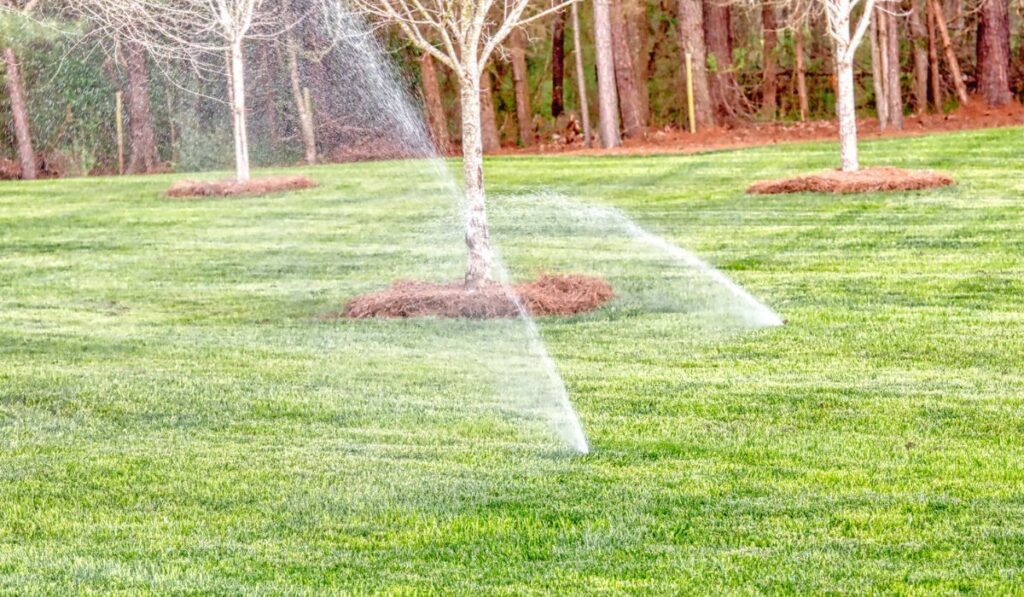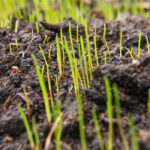Fescue grass is a cool-season grass with some peculiar warm-season properties. This shade-resistant turf grass can tolerate extreme temperatures and dry spells, and it’s got a deep root system. But how should you go about watering your fescue grass?
Fescue lawns generally require an inch of water — or 0.6 gallons — per square foot, weekly. However, the exact amount your fescue grass will need depends on the type, climate, and soil drainage. Stop watering if water pools or runs on the surface, and water in the early morning if possible.
This grass species grows well in most locations and has minimal care needs. It covers turfs or lawns in lush, vibrant green blankets year-round — as long you feed and water it appropriately. Let’s take a look at how to properly care for your fescue grass.
What Is Fescue Grass?

Renowned for its climate tolerance, fescue grass (on Amazon) is a perennial shade grass popular among American homeowners. The genus Festuca has hundreds of grass species, each with distinct benefits and uses. New cultivars and improved fescue grasses are disease-, pest-, drought-, and temperature-resistant.
Albeit they take a long time to establish themselves fully, fescue grasses have a reasonably fast germination rate. These species feature a fine leaf texture with a high leaf density. They can also flourish in poor soil conditions.
Without supplementary irrigation, fescues will become dormant in extreme heat. After rains and cooler temperatures return, they swiftly recover from dormancy.
Turf grasses like fescues can live symbiotically with endophytes. Endophytes are a type of fungus that improves the turf’s overall health. They enhance the turf’s defense against pests like insects and mammals, allowing it to thrive in harsh environments.
Types of Fescue Grass
There are various types of fescue grass, each with distinct features and benefits. Here are the broad classifications of fescue:
Fine Fescues
This fescue subgroup features fine and narrow leaf blades. They include:
- Creeping red fescue
- Chewing fescue
- Hard fescue
- Sheep fescue
If you’re looking for a low-maintenance lawn that looks attractive, consider planting fine fescues.
Fine fescues release meta-tyrosine into the soil via its roots. This amino acid acts as a herbicide, allowing the fescue to outcompete the weeds. When the roots of competing plants take the amino acid, it causes them to grow slowly or die off.
Tall Fescue Grass
Turf-type tall fescue is popular for lawns among American homeowners. The heat- and drought-resistant cultivars look and grow like other common lawn grasses. Turf-type tall fescues are shade-tolerant grasses commonly included in seed blends due to their larger leaf blade than fine species.
Compared to other common types of lawn grass, like Kentucky bluegrass and perennial ryegrass, tall fescue lawns require far less water and nutrients, and they only need to be mowed once a month.
How Often Does Fescue Grass Need to Be Watered?

Fescue watering frequency depends on various factors such as the climate and soil type. If your lawn has loam or clay soil, water fescue with 1-1.5 inches of water, or to a depth of 4 to 6 inches, weekly.
Use this watering frequency from spring to mid-summer. Since it may be challenging to apply large amounts of water to your grass without risking wasted water and runoff, divide watering into two to three days each week.
Fescues grown in sandy soil need half an inch or 0.3 gallons of water per square foot every three days. Use a wooden skewer, soil probe, or dowel to determine the water’s depth. A rain gauge (on Amazon) can help determine how much water you use on your plants.
Increase this watering frequency for fescue grass during scorching summer months. Fescue has deep roots that enable the plant to draw water from depths unreachable by other grasses. Make sure to water fescues in the early morning hours to avoid diseases.
How Long Should You Run Your Sprinklers?
The easiest way to determine how long you should water your fescue lawn is by using a can. Place a clean, empty can near your running sprinkler (on Amazon). Time how long it takes to fill the can with 1/2 inch of water. You can now calculate how long your sprinkler should run based on how many watering sessions you’re planning to have.
If you have an automatic in-ground irrigation system, place cans in different zones.
Suppose it takes 15 minutes to collect 1/2 an inch of water in the container. In this case, you can water each lawn area for 15 minutes three times per week.
Watering is most effective in the early morning. The light later in the day causes the water to evaporate too quickly. Watering in the evening or at night will increase the likelihood of lawn disease. Be careful not to overwater or water daily.
How to Tell if Your Fescue Grass Is Getting Enough Water
Lush green lawns look great and boost your home’s curb appeal. However, achieving this is challenging without enough watering. Common signs your grass needs more water include:
Dry Soil
Dry soil is one of the most common symptoms of your lawn not getting enough water. If you find your yard’s top layer of soil is dry and crumbly, it’s time to water your grass.
Footprints Lingering in the Grass
Another clue that your grass requires extra water is the presence of footprints or other tracks in the grass long after they’ve been produced. If it takes several minutes for your grass to spring back up after someone walks on it, it’s a good sign that it’s time to water.
Patchy Spots
Uneven areas are a common sign of under-watering. If you find brown or yellow areas on your lawn, it’s a sign that the grass isn’t getting enough water.
Stunted Growth
If you see your grass growing slower than usual, it might be due to a lack of water. Fescue lawns need water to flourish, so if you discover your grass isn’t reaching its full potential, it’s time to upgrade your irrigation system.








